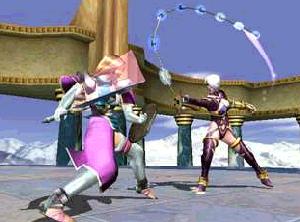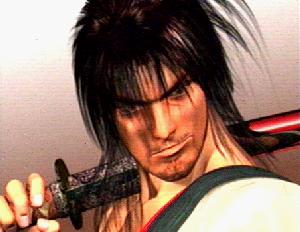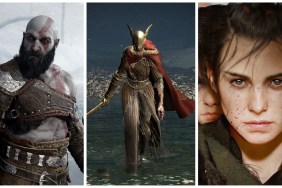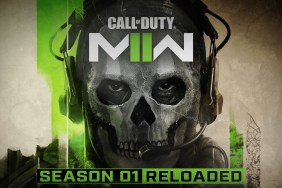Welcome to the Samurai deli.
“Transcending time and space, an eternal tale of souls and swords…” It is
the story of an evil blade that pulls together the lives of mighty warriors from
around the globe. Not all of them know why they seek the sword. Some would destroy
it, others would bend its power to their will. The one known as Voldo would subjugate
himself to it, bow before it, and perhaps if he were so bold, caress it.
But they all feel the call of the Soul Calibur.
And so do I. Soul Calibur for the Dreamcast is beautiful, deep, challenging,
and strangely compelling. This is exactly the kind of game I dread as a reviewer.
It is clearly a fantastic game, but it is also one of the very first games on
the Dreamcast and so I have little to compare it to. How should I grade such
a thing? It sings to me.
Soul Calibur is the sequel to Soul Blade,
a game that I still consider to be the best fighting game on the PSX. And while
Soul Calibur is a visual and technological marvel, the gameplay has changed
very little. This not necessarily a bad thing, but it is a safe and familiar thing,
an old thing. It means that the game is mostly better because of the graphics,
for which Sega deserves as much credit as Namco.
Let’s begin with those graphics, as that is what most people are curious about
right now. They are simply astonishing. The high-res graphics are crisp, seamless,
fast and positively stunning. In fact, they’re far better on the Dreamcast than
the arcade coin-op with the same name. The details and the flawless movement of
the characters are brilliantly done. The framerate blazes past both Superman and
his speeding bullet, making the game infinitely smoother than anything I’ve seen
on either the PSX or the N64. There’s just no comparison. This is one great lookin’
game.
The fighters have moving hair, flowing robes, changing facial expressions,
moving mouths, and even teeth. The weapons leave slick, colorful trails
as they cut through the air. The light sourcing is perfect, and casts detailed
shadows on the ground. Just take my word for it – you’ve never seen anything like
this before.
The sound is good, but not good enough to be noticeable when combined with
jaw-dropping graphics. The scores are all triumphant pieces very reminiscent of
Soul Blade on the PSX. There are lots of character
voice clips in here too, all in the original Japanese with subtitles at the bottom.
The character’s mouths move with their voices, which is great, but I think I still
would have preferred English voiceovers.
The combat system is also based heavily on Soul Blade. You have high
and low attacks, high and low blocks, and throws. There are about 100 moves for
each character, and a nearly infinite number of ways to string them together into
combos. If you have good timing, you can also parry attacks, putting your enemy
off guard for a few precious moments.
 Character
Character
design is up to par, with many returning favorites like Mitsurugi, Taki and Voldo.
There are also several new fighters like Nightmare, Maxi and Ivy. There is a greater
element of fantasy to Soul Calibur than Soul Blade, with inhuman
characters like Lizard Man and Astaroth, and even a guest appearance by Yoshimitsu
from the Tekken series. Many of the moves have gotten more extravagant
as well, with plenty of sparks and explosions and fancy lightning effects.
Of course, all the standard fighting modes are here: Arcade, VS, Survival,
Team Battle, etc. But what really set the original Soul Blade apart from
the pack was the amazing one-player depth in its Edge Master mode. Soul Calibur
matches that depth with an extensive Mission Mode. In this mode, you attempt missions
and fight under peculiar circumstances. For example, you may be in a fight where
only the throw moves will cause damage, or the weapons are invisible, or anything
else to throw a little monkey wrench in your gears.
Beat these missions to earn points, which can be then used to purchase some
of the hundreds of portraits in the Art Gallery. Beating missions and buying portraits
will open up new features, levels, characters, weapons, ‘exhibitions’, and more
missions. Rest assured, there is plenty of one-player gameplay in here.
On the other hand, while this depth blows away the likes of Tekken,
I found myself just a wee bit unsatisfied. While there are three different weapons
for each fighter in Soul Calibur, they are different in appearance only,
and have no other unique characteristics. Also, the character endings are a little
disappointing, static pictures and text replacing the multiple, multimedia endings
featured in Soul Blade.
Still, I really have to search for things to complain about… Hands down, Soul
Calibur is the best fighting game I have ever played, even though most of
the improvements over Soul Blade are purely in the graphics. It has tried
and true characters, great combat and absolutely brilliant graphics. However,
I have to award at least half of the graphical credit to the new Dreamcast system.
Do you have one yet? It’s worth buying for Soul Calibur alone.

-
Jaw-dropping graphics
-
Great fighting system
-
Smooooooooth
-
Good music
-
Lots of charactes and moves
-
Good one-player depth
-
Just like










